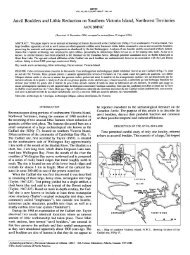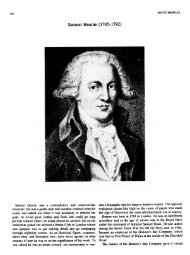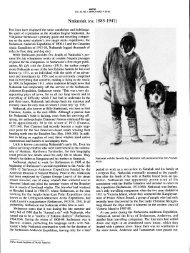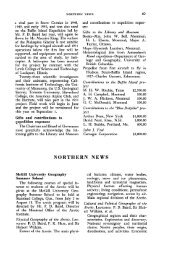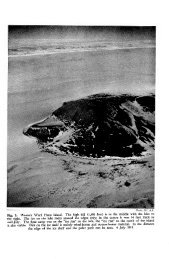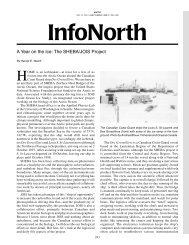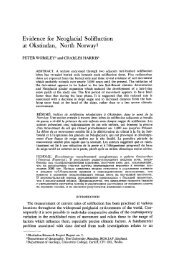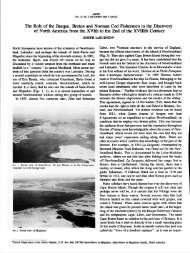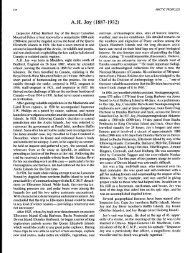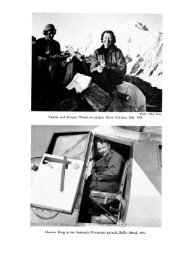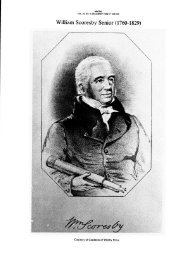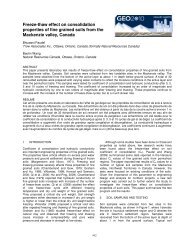Clothing in the Arctic - AINA Publications Server
Clothing in the Arctic - AINA Publications Server
Clothing in the Arctic - AINA Publications Server
Create successful ePaper yourself
Turn your PDF publications into a flip-book with our unique Google optimized e-Paper software.
66 1 T.G. SVENSSON<br />
eventually turned to a soft but fairly large cap with elaborate<br />
embellishment (Fig. 18). Recently this homed cap has been<br />
revived and its dist<strong>in</strong>ctive shape and ancient usage among<br />
most of <strong>the</strong> nor<strong>the</strong>rn Shi gives it special symbolic power.<br />
By means of different shapes of <strong>the</strong> cap women may also<br />
dist<strong>in</strong>guish marital status, as, for example, among <strong>the</strong> Skolt<br />
Shi <strong>in</strong> nor<strong>the</strong>ast F<strong>in</strong>land, who traditionally used three dissimilar<br />
caps. For unmarried girls a low head cover<strong>in</strong>g (pervesk)<br />
(Fig. 19), expos<strong>in</strong>g <strong>the</strong> entire crown, was used. Married women,<br />
on <strong>the</strong> o<strong>the</strong>r hand, wore a cap (shamshik or samsad) that was<br />
much higher <strong>in</strong> <strong>the</strong> front and also decorated <strong>in</strong> a more elaborate<br />
fashion. Widows, f<strong>in</strong>ally, had a special cap too (povednik),<br />
which was comparatively flat at <strong>the</strong> front and less<br />
lavishly ornamented (Nickul, 1948; Figs. 4, 20).<br />
Contextual Analysis<br />
In order to understand <strong>the</strong> communicative power of cloth<strong>in</strong>g,<br />
one must discover <strong>in</strong> which situations culture-specific<br />
cloth<strong>in</strong>g is used as a means to communicate identity and to<br />
confirm belong<strong>in</strong>g. Four primary types of contexts where dist<strong>in</strong>ct<br />
dresses are used can be identified. First <strong>the</strong>re is <strong>the</strong> everyday<br />
life situation related to re<strong>in</strong>deer herd<strong>in</strong>g or o<strong>the</strong>r<br />
traditional activities. In such situations dist<strong>in</strong>ctive Shi cloth<strong>in</strong>g,<br />
fairly worn out, is still <strong>in</strong> use by quite a few people as a<br />
FIG. 6. Man’s coat and cap from Kautoke<strong>in</strong>o with elaborate ornamentation.<br />
Photo: Ann Christ<strong>in</strong>e Ekk, Ethnographic Museum, Oslo.<br />
natural way to manifest attachment to a particular culture. The<br />
number reta<strong>in</strong><strong>in</strong>g SBmi cloth<strong>in</strong>g <strong>in</strong> this connection is constantly<br />
decreas<strong>in</strong>g to <strong>the</strong> advantage of more Westem-<strong>in</strong>spired<br />
cloth<strong>in</strong>g.<br />
Far more significant are contexts related to political life and<br />
cultural events. Cultural events such as wedd<strong>in</strong>gs, funerals,<br />
confirmations and special annual church holidays have had a<br />
special mean<strong>in</strong>g to <strong>the</strong> Shi ever s<strong>in</strong>ce <strong>the</strong>y were Christianized<br />
and are occasions when <strong>the</strong> f<strong>in</strong>est set of SBmi costumes,<br />
toge<strong>the</strong>r with <strong>the</strong> most precious adornments, are commonly<br />
used. Traditional market days, such as those held <strong>in</strong> Jokkmokk,<br />
Gtillivare and o<strong>the</strong>r centres of SBmi habitation, and <strong>the</strong><br />
Easter holiday celebration <strong>in</strong> Kautoke<strong>in</strong>o are o<strong>the</strong>r regular<br />
ga<strong>the</strong>r<strong>in</strong>gs where <strong>the</strong> Shi costume is frequently used.<br />
Art or handicraft exhibitions where SBmi are actively or<br />
passively present are o<strong>the</strong>r reappear<strong>in</strong>g events <strong>in</strong> which <strong>the</strong><br />
SBmi costume is highly relevant; <strong>the</strong> same is true for SBmi<br />
sports championships and diverse staged performances <strong>in</strong> <strong>the</strong><br />
fields of film, <strong>the</strong>atre and concert, as well as general cultural<br />
festivals. Those who perform, as well as <strong>the</strong> great majority of<br />
<strong>the</strong> audience, wear Simi cloth<strong>in</strong>g on <strong>the</strong>se occasions. O<strong>the</strong>r<br />
situations of a cultural nature <strong>in</strong>volve participation <strong>in</strong> <strong>the</strong> Shi school system, ei<strong>the</strong>r as a student or as a member of <strong>the</strong> school<br />
board, or <strong>in</strong> academic performances, such as public doctoral<br />
defences and scholarly conferences. In <strong>the</strong>se latter situations<br />
both <strong>the</strong> primary performer and members of <strong>the</strong> audience<br />
make a po<strong>in</strong>t of wear<strong>in</strong>g SBmi costume. To wear unmistakably<br />
Shi dress on such ceremonious occasions, with <strong>the</strong>ir special<br />
rules of etiquette and conduct def<strong>in</strong>ed exclusively by <strong>the</strong><br />
majority, conveys a message loaded with mean<strong>in</strong>g to <strong>the</strong> outside<br />
world. Here cultural pride is united with <strong>the</strong> satisfaction<br />
of academic achievements, and <strong>the</strong> most efficient visual means<br />
to present this message is by means <strong>the</strong> of Shi costume.<br />
FIG. 7. Man’s coat from Tysfjord, Central Shi type, show<strong>in</strong>g restra<strong>in</strong>ed adomments.<br />
Draw<strong>in</strong>g: Viktor Eliassen, Ethnographic Museum, Oslo.



